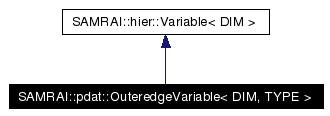
#include <source/patchdata/outeredge/OuteredgeVariable.h>
Inheritance diagram for SAMRAI::pdat::OuteredgeVariable< DIM, TYPE >:

Public Member Functions | |
| OuteredgeVariable (const string &name, int depth=1) | |
| Create an outeredge variable object having properties specified by the name and depth (i.e., number of data values at each index location). The default depth is one. The ghost cell width for all outeredge data is currently fixed at zero; this may be changed in the future if needed. | |
| virtual | ~OuteredgeVariable () |
| Virtual destructor for outeredge variable objects. | |
| bool | fineBoundaryRepresentsVariable () const |
| Return a boolean true value indicating that fine patch values take precedence on coarse-fine interfaces. | |
| bool | dataLivesOnPatchBorder () const |
It is templated on the type of the underlying data (e.g., double, int, bool, etc.). Outeredge variable data is associated with the edges of cells. However, it differs from the EdgeVariable class in that outeredge quantities reside only on the sides residing on the boundary of a patch.
Outeredge data is stored in DIM*DIM*2 arrays, containing the data for the patch boundary sides with each of the possible outward pointing normal directions. Where an outeredge falls on more than one side (patch edges and corners), the outeredge belongs to the array associated with the higher dimensional direction. In each of these arrays, memory allocation is in column-major ordering (e.g., Fortran style) so that the leftmost index runs fastest in memory. For example, a three-dimensional outeredge data object instantiated with a box [l0:u0,l1:u1,l2:u2] allocates 12 data (i.e., 3x2 pairs) arrays dimensioned as:
* * (i,j,s) * X: (X,Y,[0,1]) [l0:l0,l1:u1,l2+1:u2,d], [u0:u0,l1:u1,l2+1:u2,d] * (X,Z,[0,1]) [l0:l0,l1+1:u1,l2:u2,d], [u0:u0,l1+1:u1,l2:u2,d] * * Y: (Y,X,[0,1]) [l0:u0,l1:l1,l2+1:u2,d], [l0:u0,u1:u1,l2+1:u2,d] * (Y,Z,[0,1]) [l0:u0+1,l1:l1,l2:u2,d], [l0:u0+1,u1:u1,l2:u2,d] * * Z: (Z,X,[0,1]) [l0:u0,l1:u1+1,l2:l2,d], [l0:u0,l1:u1+1,u2:u2,d] * (Z,Y,[0,1]) [l0:u0+1,l1:u1,l2:l2,d], [l0:u0+1,l1:u1,u2:u2,d] * *
Outeredge box(i,j,s) = EdgeData<DIM>.getBox(j)
The specific data boxes are constructed based on the value of i and s. To avoid duplication of outeredge values, the data boxes in lower dimensions of i are trimmed. That is, higher dimensions (e.g. Z) take precedent over lower dimensions (e.g. X) if the databox could be defined over both.
For more information on indexing and manipulating outeredge patch data objects, see the classes OuteredgeData<DIM> and OuteredgeGeometry<DIM>.
hier::Variable<DIM>
|
||||||||||||||||
|
Create an outeredge variable object having properties specified by the name and depth (i.e., number of data values at each index location). The default depth is one. The ghost cell width for all outeredge data is currently fixed at zero; this may be changed in the future if needed.
|
|
|||||||||
|
Virtual destructor for outeredge variable objects.
|
|
|||||||||
|
Return a boolean true value indicating that fine patch values take precedence on coarse-fine interfaces.
Implements SAMRAI::hier::Variable< DIM >. |
|
|||||||||
|
Return true since the edge data index space (and hence the outeredge data index space) extends beyond the interior of patches. That is, outeredge data lives on patch borders. Implements SAMRAI::hier::Variable< DIM >. |
 1.4.2
1.4.2